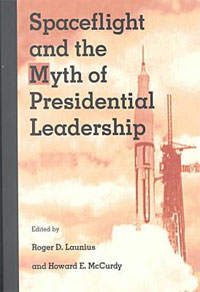Review: Spaceflight and the Myth of Presidential Leadershipby Anthony Young
|
| The reality is that formulating and funding space programs is a much more complex process than it would appear to the man on the street. |
Ever since the administration of President John F. Kennedy and his call to send astronauts to the Moon and return them safely to Earth, there has been the commonly held belief that U.S. presidents can and do drive national space policy. As the editors and contributors to Spaceflight and the Myth of Presidential Leadership are wont to point out, this is really not the case. The book title flies in the face of conventional wisdom that presidents do, in fact, help to formulate national space exploration goals and have the power to move Congress to fund those goals.
The authors in this book put forth the views that US presidents do not have that power and certainly cannot mandate the Congress to fully fund ambitious manned and unmanned exploration programs. The reality is that formulating and funding space programs is a much more complex process than it would appear to the man on the street. This myth, the authors contend, probably stems from the iconic speech President Kennedy made before Congress—as part of “Urgent National Needs”—and the seemingly unobstructed carte blanche funding the Congress agreed to provide for Kennedy’s announced space exploration programs.
What viewers and voters did not see were the behind-closed-doors Congressional meetings and intelligence briefings that took place weeks before Kennedy’s speech. The Soviet Union’s payload launch capability and obvious technical and scientific prowess and the portent they held for US national security and geopolitical power—not to mention national prestige—were the real drivers behind Congressional willingness to fund an ambitious and expensive manned space program in general and Project Apollo in particular. President Kennedy would not have made such a public request for that national commitment if the money had not already been approved. As Launius and McCurdy state in their book:
Most space supporters did not understand how truly exceptional the Apollo mandate was. After the glamor of Kennedy’s moment dimmed, space policy came to rest alongside all the other priorities of government for which presidential leadership played a diminishing role. This eventually disappointed those who believed in the power of presidents to make space exploration special. The Apollo decision was, therefore, an anomaly in the history of the U.S. space program.
The chapters in this book were among papers presented at a symposium in 1993 organized by the NASA History Office and the Center for Congressional and Presidential Studies. They include “The Reluctant Racer: Eisenhower and U.S. Space Policy” by David Callahan and Fred I. Greenstein; “Kennedy and the Decision to Go to the Moon” by Michael R. Beschloss; “Johnson, Project Apollo, and the Politics of Space Program Planning” by Robert Dallek; “The Presidency, Congress, and the Deceleration of the U.S. Space Program in the 1970s” by Joan Hoff; “Politics Not Science: The U.S. Space Program in the Reagan and Bush Years” by Lyn Ragsdale; “Presidential Leadership and International Aspects of the Space Program” by Robert H. Ferrell; and “National Leadership and Presidential Power” by John M. Logsdon. Launius and McCurdy include their own “Epilogue: Beyond NASA Exceptionalism”.
Perhaps it is because the Kennedy era and Project Apollo achieved such astounding goals for the United States that this is still seen as the model for other presidents to follow. Indeed, almost every subsequent US president has made some formal announcement for the need for a new era of American space exploration. Various advisory councils are established by presidential decree to survey the current status of America’s space program and make recommendations to the president on the direction the country to take in the years ahead. Glossy, impressive, and inspiring documents are produced to give the president, Congress, and the public recommendations and reasons why American should undertake a bold new initiative. The contributors to this book state while these efforts are laudable, they rarely have the desired effect of moving Congress, which holds the purse strings, to fund those goals.
| Perhaps it is because the Kennedy era and Project Apollo achieved such astounding goals for the United States that this is still seen as the model for other presidents to follow. |
Fifteen years have gone by since that symposium was held, but US space policy and goals remained essentially unchanged until the destruction of the space shuttle Columbia and the death of its crew on reentry in 2003. That was primarily true because the International Space Station and the space shuttle orbiter were inexorably linked. The ISS could not be completed without the shuttle orbiter, so the shuttle program continued longer than any manned spacecraft program in US history. The shuttle fleet was nearly a quarter of a century old when Columbia disintegrated during its return to Earth. No American astronauts died during missions in their Mercury, Gemini, or Apollo capsules; fourteen astronauts have died aboard two space shuttle orbiters: seven aboard Challenger during launch and seven aboard Columbia during reentry. The calls for retiring the shuttle fleet were unstoppable. That is what drove the need for a new manned spacecraft, launch vehicle and creation of Project Constellation.
Spaceflight and the Myth of Presidential Leadership will not only clarify in the reader’s mind the machinations behind US space policy and congressional funding of NASA and its programs, it might also realistically lower expectations of what the next US president will promote and achieve.
